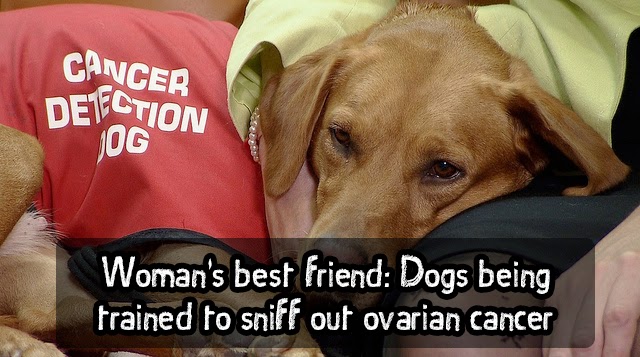By Dr. Marc Siegel
Fox News
By the time ovarian cancer is found, it’s usually too late to save the patient. Buried deep in a woman’s body, it has no telltale signs, and we doctors have no standard tests to diagnose it early.
Over 14,000 women die of ovarian cancer every year in the United States, but like many cancers, it has a characteristic odor – one that the common household dog can be trained to detect before it’s too late. At the University of Pennsylvania, using tumor specimens donated by cancer victims, researchers are putting dogs to work to sniff out cancer.
“The reason dogs are so much better than humans (in detecting cancer) is because dogs have an ability to do what I describe as smell in color,” Dr. Cynthia Otto, director of the Working Dog Center at the University of Pennsylvania School of Medicine, told FoxNews.com. “They look around the room with their nose the same way we look around the room with our eyes. And they can smell each individual component.”
While I was observing two of the cancer sniffing dogs, McBain and Ohlin, not a single error was made. Each time they went right to the container that held the cancerous tissue. The trainer rewarded the successful dogs each time with a complimentary "good boy” affirmation.
The next step in the process, which takes place at the Monell Chemical Senses Center, is to narrow down through analytical chemistry exactly which volatile odors from the cancer the dog is smelling. The researchers do this by using gas chromatography and mass spectroscopy – along with trial and error. This information will be used in the construction of an electronic sensor – or artificial ‘nano-nose’ – that may one day be used in the doctor’s office to diagnose ovarian cancer earlier.
Dr. George Preti, a chemist at the Monell Center, emphasized his hope for the future by holding up an orange and an aspirin.
“This is the size of a tumor when it is generally diagnosed,” Preti said, referring to the orange. “It is hidden inside the female. This is the size when it should be diagnosed; this is an aspirin, and it should be diagnosed when it is about this size. So this is what we are striving for – to go from here where most of the ovarian cancers are diagnosed today to here (the aspirin) or even less than this.”
Preti said that the dogs are already born with the nose, so now we have to build it. That “building” could save thousands of women from a major cancer killer. When ovarian cancer is found early, more than 90 percent of patients survive after five years. It will take an unlikely team of scientists to accomplish this: a dog expert, a renowned chemist, and the cancer specialists at University of Pennsylvania.
Bats and dolphins and their use of echoes led to the development of the ultrasound. Now it’s the turn of man’s (and woman’s) best friend to lead to the better detection of cancer.
Dr. Marc Siegel is an associate professor of medicine and medical director of Doctor Radio at NYU Langone Medical Center. He is a member of the Fox News Medical A Team and author of several books, including "False Alarm; the Truth About the Epidemic of Fear"; He is also the author of "Swine Flu and Bird Flu." His most recent book is The Inner Pulse: Unlocking the Secret Code of Sickness and Health.

No comments:
Post a Comment